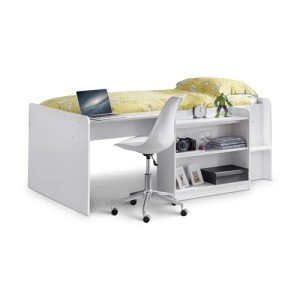Could Kids Bunk Bed Be The Answer To Dealing With 2024?
The Ultimate Guide to Kids Bunk Beds: Maximizing Space and Fun
With the increase of vertical living and smaller areas, the appeal of bunk beds has actually soared among families. Bunk beds not only provide a practical sleeping option, particularly in shared rooms, but they also bring an aspect of enjoyable into a child's life. This detailed guide explores the functions, advantages, and considerations of kids' bunk beds, making it simpler for moms and dads to pick the ideal bed for their youngsters.
Features of Kids Bunk Beds
Bunk beds are versatile pieces of furnishings that serve more than a single purpose. Here are some crucial functions to think about:
Feature
Description
Product
Bunk beds can be built from wood, metal, or a combination of both, offering varying levels of durability and style choices.
Security Features
A lot of bunk beds come geared up with guardrails, secure ladders, and capped assistances for safety, especially essential for kids.
Design Variety
Choices vary from classic styles to modern-day designs, ensuring a match for any room design.
Space-Efficiency
Bunk beds make use of vertical space, making them perfect for smaller sized spaces.
Convertible Options
Some designs can be transformed into 2 separate beds, offering flexibility as kids grow.
Storage Solutions
Some bunk beds come with built-in storage drawers or racks, helping to keep the room arranged.
Advantages of Kids Bunk Beds
Buying a bunk bed includes numerous advantages:
- Space Saving: Bunk beds maximize floor space, enabling more backyard or storage solutions.
- Enjoyable Factor: With a bunk bed, kids belong that fosters imagination and friendship during sleepovers or playdates.
- Affordable: Instead of buying two different beds, a bunk bed can accommodate 2 children at when, saving cash in the long run.
- Adaptability: Many bunk beds can be dismantled or converted into twin beds, making them a long-lasting investment as kids's requirements change.
- Social Interaction: Bunk beds motivate family bonding and friendships, supplying a welcoming space for children to share stories and laughter.
Factors to consider When Choosing a Kids Bunk Bed
When selecting the perfect bunk bed for a kid, parents should take into consideration numerous factors:
- Safety Standards: Ensure that the bunk bed complies with safety regulations and includes vital safety features.
- Age Appropriateness: Different designs cater to different age groups. For example, traditional bunk beds may not appropriate for younger kids.
- Room Dimensions: Measure the bedroom to ensure the bunk bed fits appropriately, permitting for space to move around conveniently.
- Weight Capacity: Consider the weight load of each bed and ensure it accommodates the child's weight comfortably.
- Design Preferences: Letting children take part in the choice procedure can assist them feel more fired up about their new bed.
Kinds Of Kids Bunk Beds
Bunk beds are available in different designs and configurations to match various needs:
Type
Description
Standard Bunk Bed
A traditional style with one bed stacked on top of another, usually using a ladder to access the leading bunk.
L-Shaped Bunk Bed
Functions 2 bunk beds connected in an L-shape, typically more spacious and suitable for kids sharing a room but needing a bit more space.
Triple Bunk Bed
Comprises 3 stacked beds, suitable for taking full advantage of sleeping plans in really limited areas.
Loft Bed
A raised bed with space underneath that can function as a backyard, research study corner, or additional storage.
Futon Bunk Bed
Integrates a bunk bed on the top with a futon or sofa underneath, making it great for slumber parties and maximizing space usage.
Convertible Bunk Bed
Can be separated into 2 specific beds, providing versatility as kids's needs change.
Taking Care Of Kids Bunk Beds
Maintaining bunk beds is essential for ensuring longevity and safety. Here are some simple care practices:
- Regular Inspections: Check the bed regularly for loose screws and tightened up bolts to guarantee stability.
- Tidiness: Keep bedding tidy and fresh, turning bed mattress for even wear.
- Guardrails: Ensure guardrails are safe and in location, particularly if kids tend to walk around a lot in their sleep.
- Air Circulation: Ensure the bed has sufficient airflow, preventing moisture buildup that can result in mold or mildew.
Frequently Asked Questions About Kids Bunk Beds
Q1: At what age can a kid securely use a bunk bed?
A1: Generally, kids aged 6 and older are considered safe to utilize the upper bunk due to the height and stability factors included.
Q2: Can I place a bunk bed near a window?
A2: It is suggested to avoid placing a bunk bed near windows to minimize the threat of falling or injuries.
Q3: Are bunk beds safe for younger kids?
A3: While some modern-day bunk beds include safety features accommodating more youthful kids, it is generally suggested to wait up until they are older, generally over 6 years.
Q4: What is the common weight limit for leading bunks?
A4: Weight limits vary by design but generally vary from 150 to 250 pounds. Constantly describe the manufacturer's specifications.
Q5: How frequently should I inspect the bunk bed's safety features?
A5: It is recommended to carry out a safety check every few months or whenever you see any signs of wear.
Kids' bunk beds act as a tactical service for families seeking to take full advantage of space while offering an enjoyable and engaging sleeping environment for their children. With Bunk Bed UK of alternatives available— from standard designs to loft beds— moms and dads have the flexibility to select something that meets their household's specific requirements. By considering vital factors such as safety, space viability, and their children's choices, moms and dads can make an informed option, making sure that each child is excited about bedtime while gaining from an efficient room.
